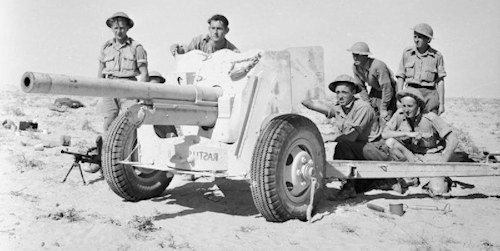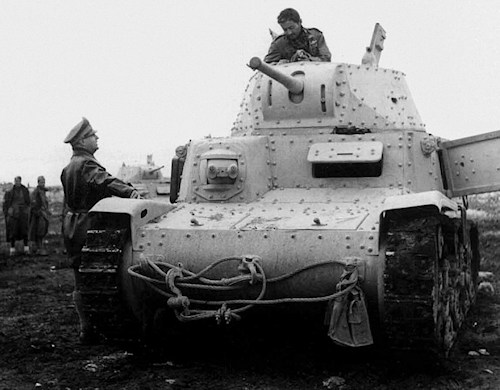In the first days of November 1942 the decisive attack of the British forces against the now disastrous Italian-German front in North Africa began. In the northern sector, the division Littorio, after several days of relentless resistance, it was reduced to a few elements.
On November 2 there were only two companies of bersaglieri and some M.14 / 41 tanks left to defend the Tell el Aqqaqir area.
The same day, the division Trento it was hit by a heavy enemy attack, being almost annihilated. The 65th and 66th battalions of the division suffered the same fate Trieste.
After 10 days of strenuous resistance, the Italian-German forces were no longer able to oppose the enemy advance. All the reserves had been used in the vain attempt to stem the immense superiority of materials and men, put in place by Marshal Montgomery.
The situation, on the other hand, in the central-southern sector of the front appeared less critical.
The divisions thunderbolt, Pavia, Bologna, Brescia e Ram they were ordered to disengage from the fighting and fall back to new positions, behind the second strip of minefields.
Then, on November 3, the Italian-German forces were entrenched in the new positions, ready to receive the "armored" impact of the Commonwealth forces.

It should be emphasized that, only in the sector of Xo Italian army corps were deployed almost 900 88mm (25 lbs) artillery pieces and that the British could count on massive air support (especially the B-24 bombers Liberator - in the photo an assembly line) offered by the Americans.
In the desert warfare, the overwhelming superiority in artillery, tanks and aircraft was instrumental in crushing the resistance of the Axis forces.
In the official historiography we talk about the Battle of El Alamein (actually divisible into three distinct phases) as the turning point - together with Stalingrad - of the Second World War.
The real turning point was the massive entry into the conflict of the United States of America.
Already in 1941 the British had received the heavy M-3 tanks Grant (English version of the chariot Lee), in 1942 Washington began to send other large quantities of armaments and equipment to the Mediterranean (the aircraft carrier Cleaning) and the 8th Army in North Africa.
However, the order, for the exhausted Italo-German forces, was of resist to the bitter end!
 Against heavy tanks Sherman e Grant (29/30 tons) the Italians could only oppose the 47/32 47 mm piece, a standard c / c weapon of the Royal Army. This piece was also the main armament of the M.13 / 40 (last photo) and M.14 / 41 tanks that equipped the Italian armored divisions in North Africa. Compared with the other guns of the same category, the Italian piece (of Austrian derivation) was the one that had the lowest initial speed (V₀) (630 m / sec.). For comparison, the British 57mm Ordnance QF (photo) boasted a muzzle velocity of 900m / sec.
Against heavy tanks Sherman e Grant (29/30 tons) the Italians could only oppose the 47/32 47 mm piece, a standard c / c weapon of the Royal Army. This piece was also the main armament of the M.13 / 40 (last photo) and M.14 / 41 tanks that equipped the Italian armored divisions in North Africa. Compared with the other guns of the same category, the Italian piece (of Austrian derivation) was the one that had the lowest initial speed (V₀) (630 m / sec.). For comparison, the British 57mm Ordnance QF (photo) boasted a muzzle velocity of 900m / sec.
Being able to count only on kinetic energy ammunition, the 47/32 was completely ineffective (unless it was possible to hit the enemy tanks at a very short distance and from the side) against the American tanks that equipped the British 8th army.
The only serious threat could be carried by self-propelled machines equipped with a 75/18 mm piece. Being able to have hollow-loaded bullets - capable of piercing 150 mm of homogeneous steel - the 75/18 mm piece was able to penetrate even the frontal armor of heavy tanks Grant e Sherman.

On 4 November, in the area between Deir el Murra and Bir al Abd, all three battalions that made up the 132nd tank rgt and about twenty 75/18 self-propelled units of the 132nd artillery rgt of the division Ram, kept in reserve during the enemy offensive, they faced the English 7th armored division.
The Italians had prepared an anti-tank defensive line to limit the enemy offensive thrust: it was completely useless. The American tanks Sherman e Grant they had 75 mm guns with 40 caliber long barrels. They stopped about 1,5 km from the Italian lines and began to target the wagons of theRam. From that distance the Italian guns were completely ineffective, in order not to be annihilated the Italian tankers had to advance and therefore be able to use their own armament. Despite the numerical and qualitative inferiority, the Italian tankers managed to inflict heavy losses on the British. Thanks to courageous and desperate assaults, numerous enemy tanks were destroyed. In the afternoon, the survivors ofRam began to fold, the 13th btg carri sacrificed itself to allow the folding.
At 15,30 pm on November 4, 1942 the last radio message of the division was sent Ram under Rommel's Command: "Enemy tanks raided south of Aries, thereby encircled Aries. Located about 5 km northeast Bir el-Abd. Aries chariots fight.".
The very few remaining tanks continued to fight to cover the retreat of the Italian-German forces towards Tunisia.
Africa was now lost forever!
Photo: web












